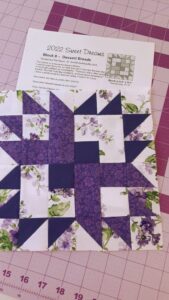If you’re looking for a charming addition to your quilt collection, the Desert Breads Quilt Block is a fantastic choice! Known for its intricate design and versatility, this quilt block combines classic elements with a modern twist, making it perfect for quilters of all skill levels. Whether you’re creating a cozy throw or a large bedspread, mastering this pattern can elevate your quilting projects to the next level.
Quilting has long been a cherished craft, blending creativity and practicality. The Desert Breads Quilt Block exemplifies this tradition, offering a beautiful geometric layout reminiscent of the shapes and textures found in desert landscapes.
Its balanced design adds visual interest, making it ideal for combining with other quilt patterns or standing out as the star of your next project.
In this tutorial, you’ll find everything you need to create your own Desert Breads Quilt Block, from fabric cutting measurements to sewing techniques. With detailed step-by-step instructions and tips, even beginners can enjoy crafting this stunning pattern. Ready to bring this timeless design to life? Let’s get started!
THE BEST QUILT PATTERNS
Step 1: Gathering Your Materials
Before diving into the construction of the Desert Breads Quilt Block, it’s essential to gather all the necessary materials. Having the right supplies on hand ensures a smoother quilting experience.
- Fabric Selection: Choose fabrics in complementary colors or prints to create a cohesive look. For the Desert Breads Quilt Block, a mix of solids and patterns works beautifully. You’ll need three fabrics:
- Fabric A: Main color (light shade)
- Fabric B: Secondary color (medium shade)
- Fabric C: Accent color (dark shade)
- Cutting Measurements:
- Fabric A: Cut four 4.5″ x 4.5″ squares
- Fabric B: Cut four 5″ x 5″ squares for half-square triangles (HSTs)
- Fabric C: Cut four 2.5″ x 5″ rectangles
- Additional Supplies:
- Rotary cutter and self-healing mat
- Quilting ruler for precise measurements
- Thread in a matching or neutral color
- Sewing machine with a ¼-inch foot for accurate seams
By preparing these materials in advance, you’ll set yourself up for success and ensure your project moves along without unnecessary interruptions.
- Planning Your Layout: Lay out your fabric pieces on a flat surface to visualize the final block. This step is crucial for ensuring the colors and shapes align as planned.
- Test Swatches: If you’re unsure about fabric combinations, test small swatches to see how they work together. This can save time and effort later in the process.
- Pressing Tools: A good iron and pressing mat will be your best friends throughout this project. Pressing seams flat keeps your quilt block neat and precise.
Step 2: Creating Half-Square Triangles (HSTs)
Half-square triangles (HSTs) are the foundation of many quilt patterns, including the Desert Breads Quilt Block. Here’s how to create them efficiently:
- Marking the Fabric: Take the four 5″ x 5″ squares of Fabric B. On the wrong side of each square, draw a diagonal line from one corner to the opposite corner using a fabric-safe marking tool. This will serve as your sewing guide.
- Pairing the Squares: Place each marked square from Fabric B right sides together with a 5″ x 5″ square of Fabric A. Pin the edges to hold the layers in place.
- Sewing Along the Lines: Sew a straight line ¼ inch away from both sides of the marked diagonal line. This creates two seams that will later form two HSTs.
- Cutting the HSTs: Using your rotary cutter, carefully cut along the marked diagonal line. This will yield two identical HST units from each square pair, for a total of eight.
- Trimming the HSTs: Trim each HST to measure exactly 4.5″ x 4.5″. Use a quilting ruler and a rotating mat for accuracy.
- Pressing the Seams: Press the seams open or to one side, depending on your preference. Open seams reduce bulk, while side-pressed seams add stability.
Step 3: Assembling the Quilt Block
With your HSTs and other fabric pieces ready, it’s time to assemble the Desert Breads Quilt Block. Follow these steps for a precise and polished finish:
- Layout the Pieces: Arrange your HSTs, 4.5″ x 4.5″ squares (Fabric A), and 2.5″ x 5″ rectangles (Fabric C) on a flat surface. Follow the traditional Desert Breads Quilt Block layout or get creative with variations.
- Joining the Rows: Sew the fabric pieces together in rows. Use a ¼-inch seam allowance for consistency. Start with the top row and work your way down, ensuring each seam is pressed as you go.
- Checking for Alignment: After sewing each row, check that the seams align correctly at the intersections. Use pins to hold pieces in place if needed.
- Sewing the Rows Together: Join the rows to complete the quilt block. Again, use a ¼-inch seam allowance and press the seams open or to one side.
- Final Press: Give the entire block a final press with your iron. This step ensures the block lies flat and is ready for use in your quilt.
- Measure the Block: The finished Desert Breads Quilt Block should measure 12.5″ x 12.5″, including seam allowances. Trim any excess fabric if necessary.
Step 4: Incorporating the Block into a Quilt
Now that your Desert Breads Quilt Block is complete, you can use it in various projects. Here are a few ideas and tips for incorporating it into a quilt:
- Single Block Projects: Use the block as the centerpiece of a pillow cover or mini quilt. This is a great way to showcase the intricate design.
- Repeating Patterns: Create multiple blocks and arrange them in a grid for a full-sized quilt. Experiment with alternating colors or orientations for added interest.
- Sashing and Borders: Add sashing (strips of fabric) between the blocks to separate and highlight each one. Borders can also frame the entire quilt and give it a polished look.
- Quilting Designs: Once your quilt top is complete, choose a quilting pattern to enhance the design. Echo quilting around the block shapes works beautifully with this pattern.
- Binding the Quilt: Finish your quilt with a binding that complements the colors of your blocks. This final step ties everything together.
- Displaying Your Work: Whether you use your quilt as a bedspread, wall hanging, or cozy throw, the Desert Breads Quilt Block will undoubtedly be a conversation starter.
PATTERN HERE
Creating the Desert Breads Quilt Block is both rewarding and enjoyable. By following this tutorial, you can confidently tackle this quilt pattern and bring your vision to life. Happy quilting!


